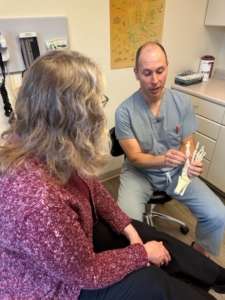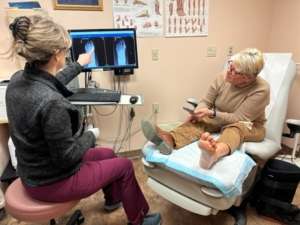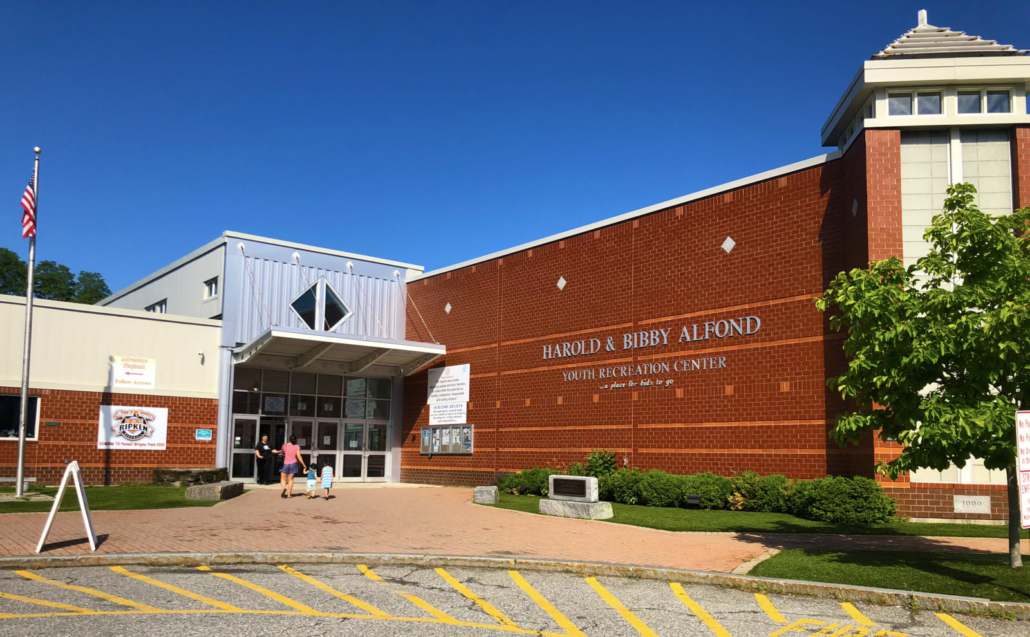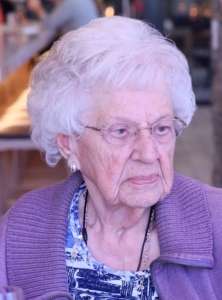
Dr. Jared Wilkinson talks with a patient about bunions at Northern Light Podiatry, in Waterville, which is on the Inland Hospital campus. Contributed photo
Bunions, those bony bumps at the base of the big toe, can be painful and disrupt a person’s daily living – even making walking painful. Approximately 25 percent of people in the U.S. have bunions, including Cherie Merrill, from Monroe, who suffered in pain for nine months.
“I’m on my feet 90 percent of the day as executive director of the Belfast Food Kitchen, and my seven grandkids keep me very active,” says Merrill. But Merrill notes, “After this awful bunion developed, I had to slow down, and by the end of each day, I was in so much pain, I couldn’t even walk. It started as a minor pain in my left foot, and progressed to worse pain as the months went on.”
After being told that different shoes could fix her issue (which it did not), Merrill was happy to learn about an innovative new bunion surgery performed at Northern Light Inland Hospital, in Waterville, and Northern Light Sebasticook Valley Hospital, in Pittsfield. Podiatric surgeons are helping people like Merrill get back on their feet using a new tool in their toolbox – a special surgery called Lapiplasty® 3D Bunion Correction®.

Dr. Ashley Mychak, who performs surgeries at Northern Light Sebasticook Valley Hospital, in Pittsfield, says the Lapiplasty 3D procedure is an exciting new way to help bunion sufferers. Contributed photo
Dr. Ashley Mychak, DPM, podiatric surgeon with Northern Light Podiatry, in Pittsfield, is very excited about Lapiplasty®. Dr. Mychak explains, “It offers a 3D correction of the bunion at the root of the problem which is an unstable joint in the midfoot. Addressing the bunion where the deformity occurs allows for better long-term correction and decreases the risk of the bunion returning. We have seen that this special surgical procedure allows for earlier weightbearing on the foot in a surgical boot and a quicker return to normal shoes than with other types of bunion surgeries.”
Dr. Jared Wilkinson, DPM, with Northern Light Podiatry in Waterville shares, “A common misconception is that a bunion can just be shaved off, but bunions are much more complicated than that. Lapiplasty® allows us to return the bone to its proper alignment.” Dr. Wilkinson adds that the procedure is still bone surgery, which takes time to heal. “Each patient’s experience will be individual, but we are typically seeing great results overall. It is very gratifying to help people get back to their favorite activities and walking in their regular shoes without pain.”
Bunions can appear in people of all ages, both male and female. While Lapiplasty® addresses the unstable joint, it also corrects the cosmetic appearance of the protruding bunion.
Dr. Wilkinson and Dr. Rich Samson perform the special surgery at Inland Hospital and Dr. Mychak at Sebasticook Valley Hospital.
At Merrill’s eight-week post-surgery checkup, Dr. Mychak called her progress excellent. Merrill is walking without her surgical boot, and she’s feeling very encouraged about her recovery so far. While each situation is different, typically, patients can get back into comfortable shoes, like tennis shoes, approximately eight weeks after the procedure.
Merrill is grateful for this new step forward. “It’s exciting to think about getting my quality of life back. I am determined not to be limping and missing out on activities when we go camping this summer with all the kids. And I’m motivated because I still have a long bucket list of dreams to achieve!”
Most insurances cover the surgery if medically necessary. Ask your primary care provider for a referral to Northern Light Podiatry, in Pittsfield or Waterville, or for more information visit northernlight.org/Bunions.




 American Legion Post #5 invites community members and families to the St Francis de Sales Cemetery wreath laying ceremony to honor deceased members of Canadian Legion Post #67, Forest J. Pare VFW Post 1285, Waterville Fire Department, Knights of Columbus #13486, Waterville Elks Lodge #905, McCrillis-Rousseau VFW Post 8835, and Law Enforcement Officers.
American Legion Post #5 invites community members and families to the St Francis de Sales Cemetery wreath laying ceremony to honor deceased members of Canadian Legion Post #67, Forest J. Pare VFW Post 1285, Waterville Fire Department, Knights of Columbus #13486, Waterville Elks Lodge #905, McCrillis-Rousseau VFW Post 8835, and Law Enforcement Officers.





 Despite unseasonably warm winter weather, the 12th annual Maine Pond Hockey Classic, held at Snow Pond, in Sidney, raised a record $52,000 for the Alfond Youth & Community Center in Waterville, which serves more than 5,000 youth in Maine. Hammond Lumber Company was the presenting sponsor.
Despite unseasonably warm winter weather, the 12th annual Maine Pond Hockey Classic, held at Snow Pond, in Sidney, raised a record $52,000 for the Alfond Youth & Community Center in Waterville, which serves more than 5,000 youth in Maine. Hammond Lumber Company was the presenting sponsor.




